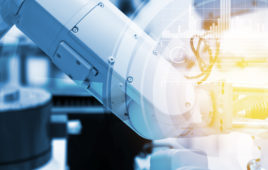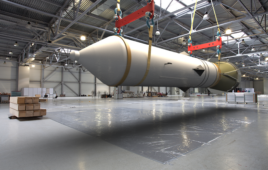In today’s episode of Technology Forward, we explore trends in additive manufacturing. I’m speaking with Arjun Aggarwal, VP of business development at Desktop Metal. Desktop Metal uses carbon fiber to make metal 3D printing with a desktop system accessible to all engineers, designers, and manufacturers.
Here are some of the key points Aggarwal noted in our conversation.
It’s still early days for the metal 3D Printing/Additive Manufacturing (3DP/)AM industry, says Arjun Aggarwal, Vice President of Business Development at Desktop Metal, “Potential users are grappling with some of this technology. Plastic 3D printing, though is becoming quite mature, as evidenced by the shift from prototyping to production.”
But there are several trends developing in this part of the industry.
For one, many in the AM industry are addressing the accessibility of the technology with the goal of helping users leverage it more. Vendors are building systems that are robust and productive enough to use in medium and high-volume application scenarios.
“This trend is about making additive manufacturing fit production, says Aggarwal. “It’s not just speed, it’s also consistency and reliability and part quality.” Then, of course, there’s the availability of materials. So, this trend is really driven by customer needs in terms of what they’re looking for to suit their applications.”
Composites
Composite materials used in metal AM can fill the need for strong material performance, high strength, and lighter weight. “People are looking at how to replicate industry best practices of more traditional composite manufacturing processes,” says Aggarwal. “Looking at continuous fiber reinforcement is big. We are taking, I think, a unique approach with our new fiber printer, which we launched last fall, where we’re trying to develop an analogous process to the tape lay-up process. The automated tape placement process is used widely in industries like aerospace. So, we’ve basically taken that and adapted it for use alongside our extrusion-based 3D printer. I think this is a big trend, looking at how continuous fibers can reinforce and achieve that high strength-to-weight ratio.”
Aggarwal continues, “I think the challenge to overcome is not specifically related to composites in and of themselves, it’s more related to 3D printed composites and specifically parts made out of chopped fiber, which is the traditional kind of filament-based material. If you have a composite 3D printer today, for the most part, you’re going to be using chopped fiber reinforced filament versus continuous fiber tape.” The chopped fiber is different from what users may be used to.
“It’s more about getting end users familiar with how 3D printed composite parts perform. That’s a matter of testing and third-party validation. So, it’s early in the continuous fiber industry for 3D printing.”
A horizontal technology
“I think we are starting to see the promise of 3D printing, which is, at its best, more of a horizontal technology than a vertical one. And it’s more about how are you going to use the system than what industry you’re in.
In industries such as aerospace and medical, part quantities have been low enough that powder bed fusion is the dominant additive technology in the industry today. These industries do not need tens of thousands or hundreds of thousands of parts per year. When the need for that quantity arises, binder jetting is a viable choice.
As metal additive technology becomes more accessible at the low end and more productive at the high end, other industries, such as automotive, consumer electronics, consumer products, machine design, and machine tooling are adopting it.
Flexibility
“I think first and foremost, one of the things that 3D printing allows is for design flexibility.” Such flexibility includes new design paradigms, considerations, aspect ratios, hole sizes, overhanging angles, and so on. “These may or may not all be things that design engineers had to think about in the past,” says Aggarwal.
3D printing offers opportunities to improve the performance of parts. “Things like light-weighting for example. This is really hard to do in traditional manufacturing. In 3D printing, you can use lattice structures or infill techniques, which is not something you cannot easily do with traditional manufacturing processes. You can reduce the amount of material that’s being used to save costs.
“It’s more a matter of exposure and starting to look at parts and say, “Maybe it works with 3D printing. How can I really take advantage of the technology?” Users can batch produce multiple different design prototypes at once to see which comes out the best. Thus, this technology can be invaluable to design engineers.
Aggarwal sees binder jet 3D printing as the future of metal additive manufacturing. “It is a technology that really lends itself well to high volume production.” Desktop Metal is focused on making binder jet 3D printing a high-speed and robust process, focusing on consistency and reliability.
Generative design
Trends in software include generative design. Desktop Metal offers a generative design software tool, Live Parts. Aggarwal notes that this program designs parts in a unique way that’s analogous to 3D printing where the part is “growing” over time. “And in real time, so that users can adjust it themselves and see if I push this and increase that force, how does the part change, or if I add that constraint, how does the part change?
So that’s an area of focus for the company and we’re actually leveraging that simulation technology to facilitate some of our hardware efforts as well.
The supply chain
C-suite executives are starting to think about the impact of supply chain reorganization in the wake of coronavirus. “We’ve seen just how important it is to have a flexible manufacturing architecture. For all intents and purposes, when much of the country’s manufacturing capacity was shut down, you had 3D printers all over the country, continuing to manufacture and provide parts from designs that were created on a daily basis because you don’t have that tooling requirement.
“There’s a whole bunch of ways that you can leverage that flexibility proactively for business results. And I think that, unfortunately, it took this kind of event for many in the world to understand the power that 3D printing offers, but nonetheless, I think a lot of people are awakened to that.
“I would expect those considerations will take hold at a C-suite level and you will start to see companies leveraging 3D printing in a more strategic way for supply chain flexibility, for on-demand manufacturing, to limit the inventory that they need physically onsite, to limit the tooling requirements, and to simplify their manufacturing. So maybe instead of shipping sub-components and assemblies all around the world, they can instead be shipping just raw materials and housing all their digital files in central databases. This is a broader trend. Will it take hold and empower through the industry in the next year or two years? I don’t know. I think certainly in the longer term, and especially in the wake of coronavirus, that’s something that we may see in the medium to longer term.
“I think people will start to look at the technology more seriously at a strategic level versus maybe at the level of, ‘I need to solve this one problem.’ But for right now, the majority of our customers are coming to us saying, “We need to make this part more economically,” or “We need to improve the performance of this part,” or “We need that part faster.” And that’ll always be the norm, but I suspect we’ll see a more strategic lens put on it in the medium to long term.”
Filed Under: Aerospace + defense, Make Parts Fast, PODCASTS




